Notes: Belfast Queens Quay was the terminus of the Belfast & County Down Railway (B&CDR). The station was originally the western terminus of the 4-mile Belfast & Holywood line which opened on 2 August 1848. The station was located on the east side of the River Lagan at Queens Quay and close to the Queens Bridge which linked east Belfast to the central area. At the time of opening the station was a timber structure that included a trainshed but work was already underway on a more permanent station just to the south. Less than two years after the Holywood branch had opened a line was added to Newtownards via Comber on 6 May 1850. Trains on the new route were the first to use the permanent station but until 19 December 1850 Holywood branch trains continued to use the temporary station. After that date the wooden trainshed of the original station became B&CDR workshops.
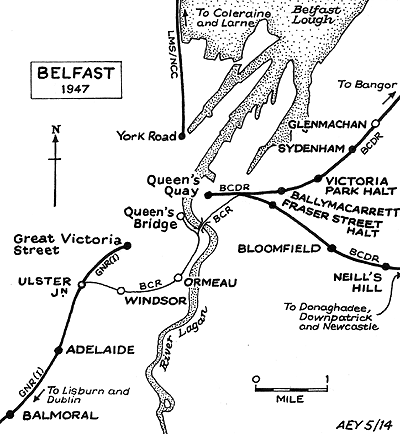 The 1850 station also fronted onto Queens Quay. It was constructed in classical style, the two-storey stone-built frontage having eleven arched openings at ground and first-floor level; on the ground floor the arcading was topped with keystones whilst pediments were placed above the windows on the upper level. The elevation was completed with a balustrade. Behind the building were departure and arrival platforms enclosed by a trainshed roof. On 23 March 1859 the B&CDR reached Downpatrick, the county town of Down. The 1850 station also fronted onto Queens Quay. It was constructed in classical style, the two-storey stone-built frontage having eleven arched openings at ground and first-floor level; on the ground floor the arcading was topped with keystones whilst pediments were placed above the windows on the upper level. The elevation was completed with a balustrade. Behind the building were departure and arrival platforms enclosed by a trainshed roof. On 23 March 1859 the B&CDR reached Downpatrick, the county town of Down.
During the late 1850 the B&CDR was considering building lines to Donaghadee and to Bangor. Originally the plan was to reach Bangor via Donaghadee but the more obvious route was via the Holywood branch which could be extended. However the company was not able to generate enough funds to build both lines so a separate one was formed to extend the Holywood branch. The new company was the Belfast, Holywood & Bangor Railway (BH&BR) and in 1860 they built an island platform alongside the B&CDR station at Queens Quay. It was provided with a glazed iron canopy and was first used in March 1860.
On 3 June 1861 the B&CDR line to Donaghadee opened and on 18 May 1865 the BH&BR Holywood and Bangor line opened. Shortly after the Bangor line opened the B&CDR leased the Holywood branch to the BH&BR for a down payment of £50,000 and an annual rent of £5,000 per year. They also transferred a sizeable portion of Queens Quay station to the BH&BR along with many of the staff who worked there. The Bangor line was very profitable and was worked separately from the rest of the B&CDR system.
From 25 March 1869 B&CDR trains began to serve Newcastle.
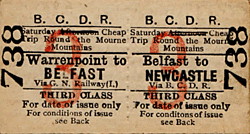 Until 12 May 1876 the B&CDR and BH&BR were physically isolated from the other railways of Ireland. On that date a junction was installed at Ballymacarrett (half a mile to the east of Queens Quay) which provided a link to the Belfast Central Railway (BCR) which in turn linked to the Great Northern Railway [Ireland] (GNR[I]). The line was used for the transfer of goods and by excursion trains. Until 12 May 1876 the B&CDR and BH&BR were physically isolated from the other railways of Ireland. On that date a junction was installed at Ballymacarrett (half a mile to the east of Queens Quay) which provided a link to the Belfast Central Railway (BCR) which in turn linked to the Great Northern Railway [Ireland] (GNR[I]). The line was used for the transfer of goods and by excursion trains.
In 1884 the B&CDR absorbed the BH&BR by which time Belfast Queens Quay had become a very busy station. A dividing wall between what had been the B&CDR and BH&BR parts of the station was taken down and extensions were made. Since 1850 goods and workshop facilities had been developed to the east of the station and they continued to expand during the last two decades of the nineteenth century.
The December 1895 timetable showed 39 departures on weekdays. There were additional trains on Saturdays and 10 departures on Sundays. Destinations served included Bangor, Donaghadee, Downpatrick, Holywood and Newcastle. The majority of the departures went to Bangor.
At the dawn of the twentieth century the B&CDR was operating a network of 76 route miles and it was carrying over 4 million passengers annually. The Bangor line was the busiest with an intensive commuter service.
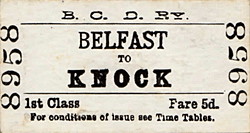 In 1910 work began on a rebuild of Queens Quay station. Two-storey wings were added either side of the original structure. They perfectly complemented the old building, with the same style of arcading and balustrade; however they were not symmetrical, the north-west wind being longer. The fenestration continued a short way on the south-east and north-west elevations. A pitched roofed porte-cochère extended almost the length of the original building, and the five south-west facing openings were arched to match those of the station building; the outer pair were doorways and the three central ones were windows. In 1910 work began on a rebuild of Queens Quay station. Two-storey wings were added either side of the original structure. They perfectly complemented the old building, with the same style of arcading and balustrade; however they were not symmetrical, the north-west wind being longer. The fenestration continued a short way on the south-east and north-west elevations. A pitched roofed porte-cochère extended almost the length of the original building, and the five south-west facing openings were arched to match those of the station building; the outer pair were doorways and the three central ones were windows.
Behind the building new waiting rooms and lavatories were built. A new five platform trainshed was built, with three pitched profile structures topped by ventilators; the south-eastern portion was considerably shorter than its neighbours. The platforms were numbered 1 to 5 from south to north.
A tramway of the Belfast Corporation was extended into the station. It entered the covered trainshed on the southern side of the station behind the southern wing of the extended station frontage. This allowed passengers to change between train and tram under cover.
The new station facilities at Queens Quay were completed by 1913.
During the Great War passenger traffic remained constant, in part owing to the establishment of military bases adjacent to the B&CDR network. Government control of all railways in Ireland was imposed in 1916 and continued after the armistice of 11 November 1918 until 1 January 1920.
The Irish War of Independence which followed the Great War resulted in the partition of the island of Ireland into two countries, the Irish Free State and Northern Ireland, the latter remaining part of the United Kingdom. Belfast became the capital city of Northern Ireland. Unlike some of the other railway companies of Ireland the B&CDR had all of its route mileage within one state, Northern Ireland, which gave it a degree of stability.
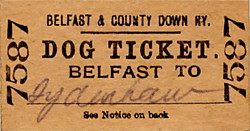 The July 1922 timetable showed 40 departures from Belfast Queens Quay on weekdays. The Bangor line still enjoyed the most intensive service. On Saturdays there was an even more intensive service on the Bangor line. On Sundays there were 8 departures. The July 1922 timetable showed 40 departures from Belfast Queens Quay on weekdays. The Bangor line still enjoyed the most intensive service. On Saturdays there was an even more intensive service on the Bangor line. On Sundays there were 8 departures.
Bus services were deregulated after the Great War and the growth of the results had an adverse effect on the main line passenger traffic of the B&CDR. By 1922 private buses were operating in competition both with each other and with the railway. There were several reasons for the competitive advantage of buses. Road transport undercut railway fares, which required the railway to reduce its fares too. Some of the stations were remote from the centres of villages which buses could serve more conveniently. Distances between Queens Quay and Donaghadee and Newcastle were much longer by rail than by road; however the Bangor line was more direct and did not suffer as much from bus competition. From 1927 the railway began to operate its own buses and gradually bought out most of the competition.
The outbreak of the Second World War on 3 September 1939 improved the financial situation for the B&CDR as once again the railways became essential to the war effort. The July 1940 working timetable (seen below) showed 22 departures for Newcastle line destinations on Monday-to-Friday as shown on the working timetable below. There would have been as many departures for the Bangor line.
To see a larger version of the July 1940 working timetable click here
Air raids in the spring of 1941 resulted in many Belfast citizens finding accommodation out of town which in turn resulted in more passenger journeys as they had to travel into Belfast to their places of work. When the USA entered the war at the end of 1941 Northern Ireland became a vast armed camp from which the railways benefited. Compared to the other railway companies in Belfast the B&CDR suffered few losses during the war and Queens Quay station remained intact.
When the war ended the B&CDR was faced with another wave of competition from bus companies. Faced with this competition the company proposed the closure of all of its lines except the Bangor branch. Because of the financial situation the company was nationalised and merged with the Northern Ireland Road Transport Board to form the Ulster Transport Authority (UTA) on 1 October 1948.
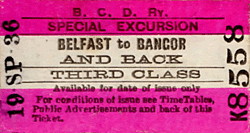 Public opinion was generally favourable as there had been promises of modernisation. It had been expected that some of the less-used branches would close, but it came as a shock when the UTA announced in late 1949 that it was going to close the entire B&CDR network with the exception of the Bangor branch, a situation that nationalisation was supposed to avoid. The main line to Newcastle and the branches to Ballynahinch and Ardglass closed on 16 January 1950. Left with only the service to Bangor the station at Queens Quay went into decline. Although it saw some modernisation in the form of the introduction of diesel multiple units (DMUs) the trainshed roof fell into disrepair and had been removed by the 1960s. Public opinion was generally favourable as there had been promises of modernisation. It had been expected that some of the less-used branches would close, but it came as a shock when the UTA announced in late 1949 that it was going to close the entire B&CDR network with the exception of the Bangor branch, a situation that nationalisation was supposed to avoid. The main line to Newcastle and the branches to Ballynahinch and Ardglass closed on 16 January 1950. Left with only the service to Bangor the station at Queens Quay went into decline. Although it saw some modernisation in the form of the introduction of diesel multiple units (DMUs) the trainshed roof fell into disrepair and had been removed by the 1960s.
On 31 July 1965 the former BCR was closed which isolated the Bangor line from the rest of the UTA network (in much the same way as the B&CDR had been before 1876). By this time the UTA had dramatically reduced the railway network of Northern Ireland and seemed set to close what was left. Before it could do its worst the UTA was broken up with effect from 5 April 1968. The railways within its remit became part of Northern Ireland Railways (NIR). NIR was a much more pro-rail organisation and it set about improving what was left of the network.
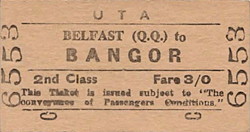 NIR inherited a very run-down Queens Quay station but a relatively busy Bangor line and developed a plan to reopen the former BCR and create a new Belfast Central station on the line. The purpose was to link the Bangor line to the former GNR[I] line that ran into Belfast Great Victoria Street from the south. Work began on the line in 1973 and it opened on 12 April 1976. Belfast Queens Quay station closed on the same day and Bangor line trains were diverted to run to Belfast Central. NIR inherited a very run-down Queens Quay station but a relatively busy Bangor line and developed a plan to reopen the former BCR and create a new Belfast Central station on the line. The purpose was to link the Bangor line to the former GNR[I] line that ran into Belfast Great Victoria Street from the south. Work began on the line in 1973 and it opened on 12 April 1976. Belfast Queens Quay station closed on the same day and Bangor line trains were diverted to run to Belfast Central.
After closure the site of Belfast Queens Quay became a NIR servicing depot. The passenger station was demolished. The depot remained in use until 1995. It was closed following the opening of a new line between Belfast Central and Belfast York Road on 28 November 1994. The new line connected the railways that had run into Belfast York Road station to the former GNR[I] line. The NIR developed York Road as its servicing depot which allowed the facilities at Queens Quay to be closed. The depot was demolished and all the lines between Queens Quay and Ballymacarrett Junction were lifted. Part of the station site was developed with a road, and part with an office building.
Tickets from Michael Stewart, working timetable from Ernie Brack and route map by Alan Young
Sources:
- Belfast & County Down Railway - An Irish Railway Pictorial, Desmond Coakham, Midland Publishing Ltd, 1998.
- Bradshaws July 1922 Railway Guide, Guild Publishing
- One Hundred & Fifty Years of Irish Railways, Fergus Mullighan, Appletree Press 1983
- Railways in Ireland Part Two, Martain Bairstow, 2007
- The Great Northern Railway - an Irish Railway Pictorial, Tom Ferris, Midland Publishing, 2003.
|

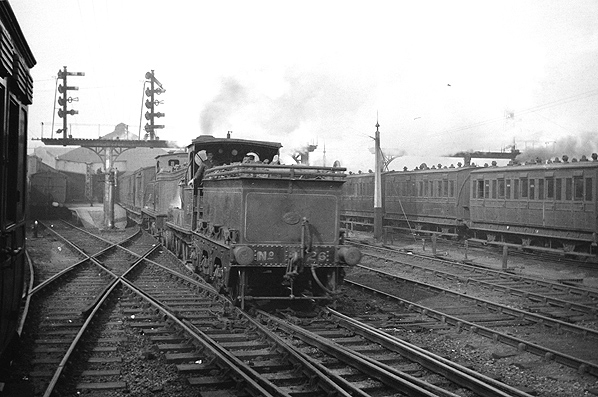
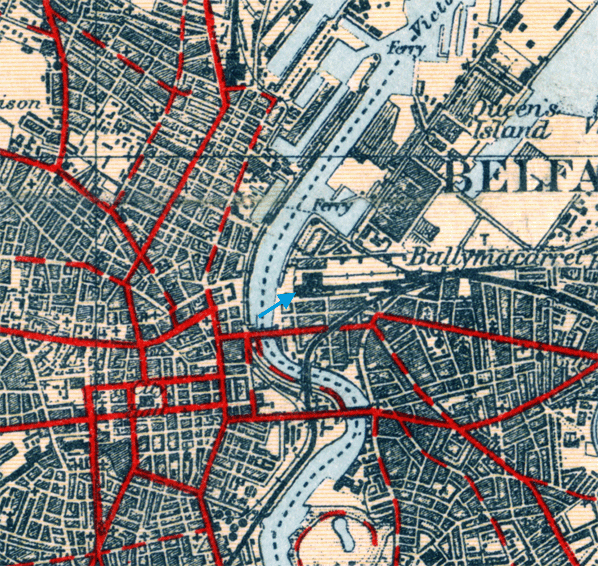
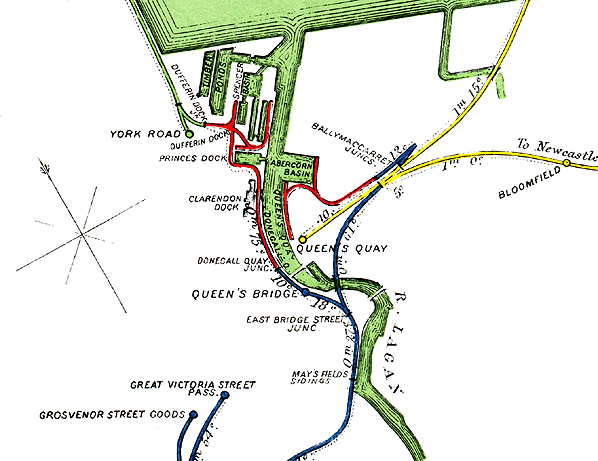
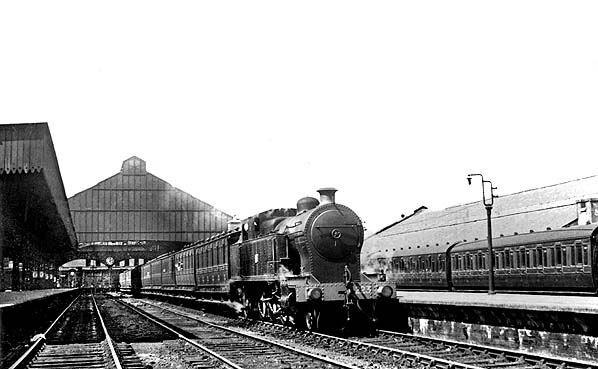
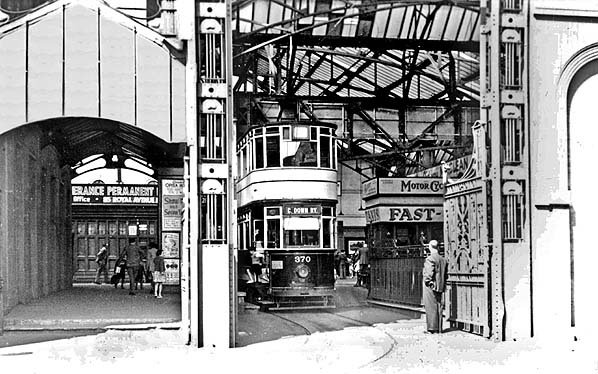
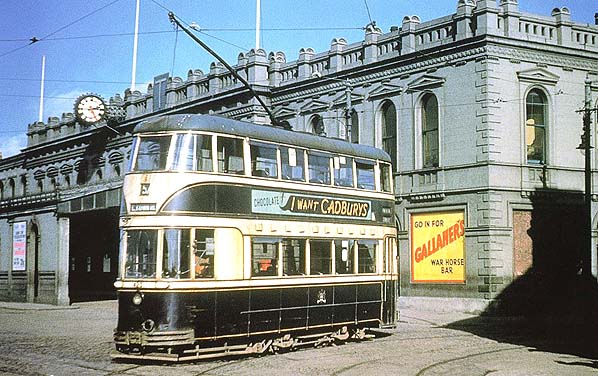
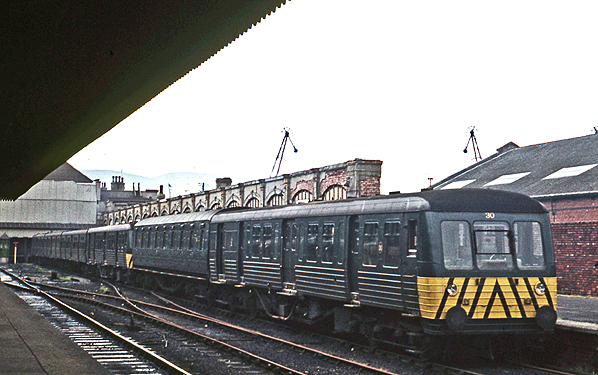
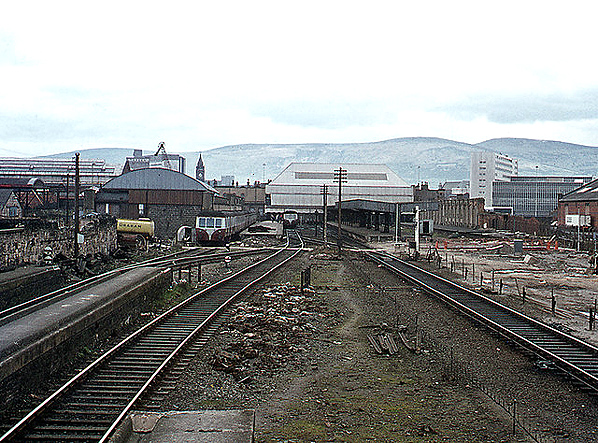
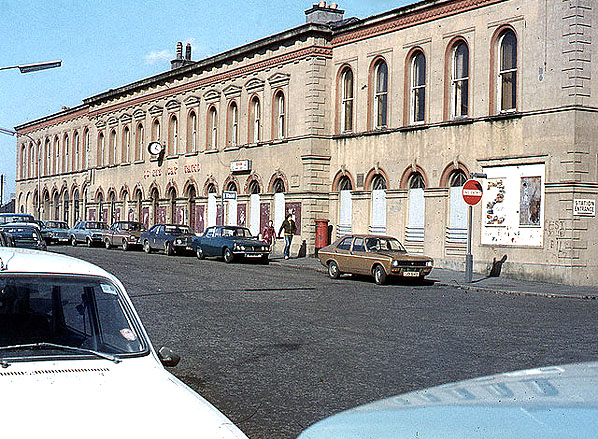
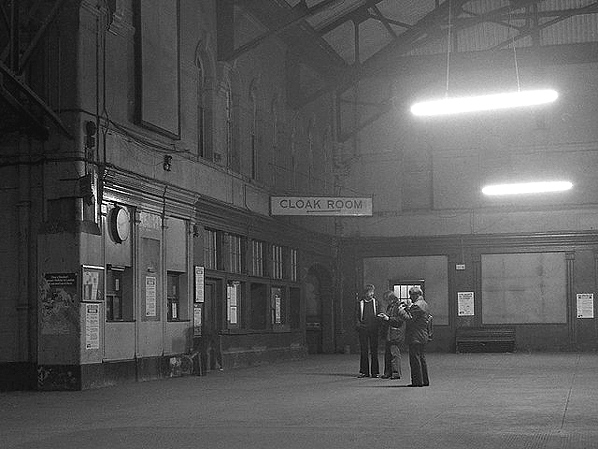
.jpg)
.jpg)
 The 1850 station also fronted onto Queens Quay. It was constructed in classical style, the two-storey stone-built frontage having eleven arched openings at ground and first-floor level; on the ground floor the arcading was topped with keystones whilst pediments were placed above the windows on the upper level. The elevation was completed with a balustrade. Behind the building were departure and arrival platforms enclosed by a trainshed roof. On 23 March 1859 the B&CDR reached Downpatrick, the county town of Down.
The 1850 station also fronted onto Queens Quay. It was constructed in classical style, the two-storey stone-built frontage having eleven arched openings at ground and first-floor level; on the ground floor the arcading was topped with keystones whilst pediments were placed above the windows on the upper level. The elevation was completed with a balustrade. Behind the building were departure and arrival platforms enclosed by a trainshed roof. On 23 March 1859 the B&CDR reached Downpatrick, the county town of Down.  Until 12 May 1876 the B&CDR and BH&BR were physically isolated from the other railways of Ireland. On that date a junction was installed at Ballymacarrett (half a mile to the east of Queens Quay) which provided a link to the Belfast Central Railway (BCR) which in turn linked to the Great Northern Railway [Ireland] (GNR[I]). The line was used for the transfer of goods and by excursion trains.
Until 12 May 1876 the B&CDR and BH&BR were physically isolated from the other railways of Ireland. On that date a junction was installed at Ballymacarrett (half a mile to the east of Queens Quay) which provided a link to the Belfast Central Railway (BCR) which in turn linked to the Great Northern Railway [Ireland] (GNR[I]). The line was used for the transfer of goods and by excursion trains.  In 1910 work began on a rebuild of Queens Quay station. Two-storey wings were added either side of the original structure. They perfectly complemented the old building, with the same style of arcading and balustrade; however they were not symmetrical, the north-west wind being longer. The fenestration continued a short way on the south-east and north-west elevations. A pitched roofed porte-cochère extended almost the length of the original building, and the five south-west facing openings were arched to match those of the station building; the outer pair were doorways and the three central ones were windows.
In 1910 work began on a rebuild of Queens Quay station. Two-storey wings were added either side of the original structure. They perfectly complemented the old building, with the same style of arcading and balustrade; however they were not symmetrical, the north-west wind being longer. The fenestration continued a short way on the south-east and north-west elevations. A pitched roofed porte-cochère extended almost the length of the original building, and the five south-west facing openings were arched to match those of the station building; the outer pair were doorways and the three central ones were windows. The July 1922 timetable showed 40 departures from Belfast Queens Quay on weekdays. The Bangor line still enjoyed the most intensive service. On Saturdays there was an even more intensive service on the Bangor line. On Sundays there were 8 departures.
The July 1922 timetable showed 40 departures from Belfast Queens Quay on weekdays. The Bangor line still enjoyed the most intensive service. On Saturdays there was an even more intensive service on the Bangor line. On Sundays there were 8 departures.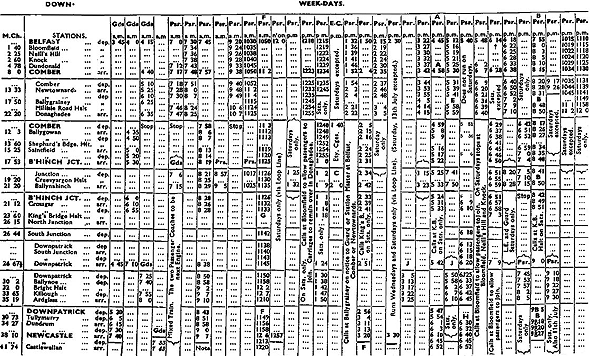
 Public opinion was generally favourable as there had been promises of modernisation. It had been expected that some of the less-used branches would close, but it came as a shock when the UTA announced in late 1949 that it was going to close the entire B&CDR network with the exception of the Bangor branch, a situation that nationalisation was supposed to avoid. The main line to Newcastle and the branches to Ballynahinch and Ardglass closed on 16 January 1950. Left with only the service to Bangor the station at Queens Quay went into decline. Although it saw some modernisation in the form of the introduction of diesel multiple units (DMUs) the trainshed roof fell into disrepair and had been removed by the 1960s.
Public opinion was generally favourable as there had been promises of modernisation. It had been expected that some of the less-used branches would close, but it came as a shock when the UTA announced in late 1949 that it was going to close the entire B&CDR network with the exception of the Bangor branch, a situation that nationalisation was supposed to avoid. The main line to Newcastle and the branches to Ballynahinch and Ardglass closed on 16 January 1950. Left with only the service to Bangor the station at Queens Quay went into decline. Although it saw some modernisation in the form of the introduction of diesel multiple units (DMUs) the trainshed roof fell into disrepair and had been removed by the 1960s. NIR inherited a very run-down Queens Quay station but a relatively busy Bangor line and developed a plan to reopen the former BCR and create a new Belfast Central station on the line. The purpose was to link the Bangor line to the former GNR[I] line that ran into Belfast Great Victoria Street from the south. Work began on the line in 1973 and it opened on 12 April 1976. Belfast Queens Quay station closed on the same day and Bangor line trains were diverted to run to Belfast Central.
NIR inherited a very run-down Queens Quay station but a relatively busy Bangor line and developed a plan to reopen the former BCR and create a new Belfast Central station on the line. The purpose was to link the Bangor line to the former GNR[I] line that ran into Belfast Great Victoria Street from the south. Work began on the line in 1973 and it opened on 12 April 1976. Belfast Queens Quay station closed on the same day and Bangor line trains were diverted to run to Belfast Central. 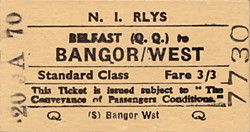
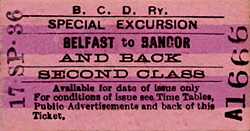

 Home Page
Home Page